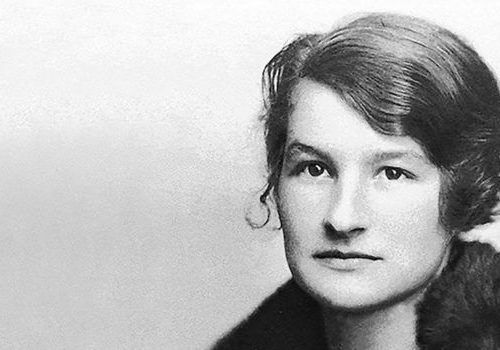
Virginia Hall was an American woman who became the most dangerous Allied spy in occupied France. Despite an ill-fitting wooden leg that caused constant discomfort, Virginia was a highly effective intelligence agent who created modern guerrilla warfare.
Born to a wealthy family in Baltimore in 1906, Virginia was a tomboy and a top student. She was voted “most original in our class” in her prep school yearbook. From her privileged background, Virginia could have been a socialite, a woman of leisure, but instead she pursued higher education and an exciting career.
Virginia attended Radcliffe College and Barnard College, where she studied European languages. She went to Europe to finish her studies, and became fluent in French, German, Italian, Russian and Spanish. Wanting to serve her country and travel the world, Virginia applied for a job in the U.S.Foreign Service, but was rejected because she was a woman. At the time, only 6 out of 1500 staffers were female.
Unable to land an official Foreign Service position, Virginia traveled to Warsaw, where she got a job as a clerk at the American Embassy in 1931. She enciphered outgoing telegrams, decoded incoming ones, and processed visas. Virginia was transferred to the U.S. Consulate in Smyrna, Turkey at age 27. On a hunting trip with friends in Turkey in 1933, Virginia shot herself in the foot while hunting. Gangrene set in and her left leg had to be amputated below the knee. She was fitted with a hollow wooden leg which she named Cuthbert.
She returned home to Baltimore for treatment, and again applied to join the Foreign Service. This time she was rejected for being disabled. Despite intense lobbying by well-connected family friends, FDR refused to alter the rules preventing disabled people from serving in the Foreign Service. Ironically, he was in a wheelchair himself.
As World War II began, Virginia refused to remain on the sidelines. She went to Paris as a civilian, and was there when the Nazis invaded in 1940. She volunteered to drive ambulances for the French army on the front line, and bravely rescued the wounded while German fighter planes fired from above.
When France surrendered to Germany, Virginia fled to England. At a cocktail party, she was recruited by Vera Atkins, the British spymaster who inspired the character of Miss Moneypenny in the James Bond series. Virginia joined the Special Operations Executive (SOE), a new spy agency created by Winston Churchill to “set Europe ablaze.”
Virginia was sent back to occupied France with false papers identifying her as a journalist with the New York Post. She was the first spy in France working for the SOE and spent the next fourteen months directing French Resistance activities. She kept track of German troop movements and radioed information to her Allied handlers. Virginia recruited a network of French spies to work for the Resistance.
The Germans called her “The Limping Lady” and put her at the top of their most wanted list. The notorious Gestapo chief Klaus Barbie said, “I would give anything to get my hands on that limping Canadian b——.” She wasn’t Canadian, of course, but German intelligence never figured out who she was or where she came from, as she constantly changed her appearance and used more than 20 different aliases.
In 1942, the Nazis occupied all of France and arrested hundreds of Resistance figures. Virginia escaped by train to Perpignan in the South of France, and then hiked through the Pyrenees mountain range to Spain. She walked 50 miles in two days, suffering constant pain because of her leg, which was often bleeding. Before she escaped, Virginia signaled to the SOE that she hoped Cuthbert would not give her too much trouble on the journey. The SOE operative who received the message did not understand the reference and replied, “If Cuthbert troublesome, eliminate him.”
As soon as she reached Spain, Virginia was arrested by the Spanish authorities for illegal border crossing, but the US Embassy was able to secure her release. She continued working for the SOE in Madrid and London, and then asked to return to France. Because of her artificial leg, she couldn’t parachute in, so she was taken by torpedo boat to Brittany. She mapped drop zones for Allied commandos and supply chains to enter France.
Virginia trained three battalions of Resistance fighters to wage guerrilla warfare against the German occupiers. Her unlikely lieutenants included a brothel madam and a doctor specializing in venereal diseases. She taught teachers and farmers how to blow up bridges. Virginia masterminded a successful plot to rescue twelve male Resistance fighters who’d been captured by the Germans. The guerrilla warfare techniques that Virginia developed are still in use by the CIA and other spy agencies today.
In 1945, after the war ended, the US Army presented Virginia with a Distinguished Service Cross in recognition of her brave work with the French Resistance. It was the only DSC awarded to a civilian woman in World War II. President Truman wanted to announce it publicly, but Virginia asked to keep the honor secret, as she was “still operational and most anxious to get busy.” She was made an honorary member of the Order of the British Empire, and was awarded the Croix de Guerre by France.
Virginia joined the CIA in 1951, and worked as an intelligence analyst. Recently declassified papers show that Virginia was repeatedly passed over for promotion in favor of less capable male colleagues. She retired to a farm in Maryland in 1966, and died in 1982, at age 76.
For her brave actions as a leader of the French Resistance, we honor Virginia Hall as this week’s Thursday Hero.
Get the best of Accidental Talmudist in your inbox: sign up for our monthly newsletter.